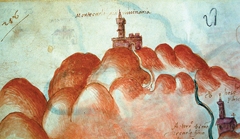
Background
Occupations and wars between Pisa, Lucca and Florence
Looted and set on fire Vivinaia (1331) by Florentine army in retreat after the unsuccessful siege of Lucca, the inhabitants of that town, grew up around the ancient villa (eleventh century) of the Marquis of Tuscany and Countess Matilda, sought refuge on the top of the hill montecarlese at the fortress of Cerruglio, where a few years earlier (1328) eight hundred lances rebels had barricaded the Emperor Louis of Bavaria.
Here, with the support and encouragement of Prince Charles of Bohemia (later Emperor CHARLES IV), the government of Lucca began the construction of the village, surrounded by walls and guarded by a fortified wall with a triangular base, acting as pivot and closed MASTIO two towers, probably belonging to the ancient Cerruglio.In honor of the Bohemian prince (son of John and grandson of King HENRY VII) the new VILLAGE - CASTLE MGR was called CAROLI, Mount CARLO. The fortifications of the village, supported entirely by LUCCHESI, were carried out between 1333 and 1339.With the conquest of Lucca by Pisani (1342), Monaco became an important center of the Vicariate of the border, directly managed by the city of Pisa. In 1374, the recapture of freedom of Lucca, after the period of domination of Pisa, Monte Carlo became the capital of vicarious Valleriana and resided there, a few exceptions, the Vicars of Lucca. In this period (1393 - 1400), by the Master LANFRANCO from Como, was largely rebuilt the two towers connected to MASTIO and traditionally known by the names of the apparition of TORRE (towards LUCCA) and Tower of Santa Barbara (to PESCIA ). Given its extraordinary strategic importance, since the foundation, Monaco was the scene of battles between Pisa, Florence and Lucca, for the domain of Valdinievole and Lucca. In 1437 Monaco was conquered by Francesco Sforza, the future Duke of Milan and then headed by Captain General of the LEAGUE against LUCCA and FIRENZE VISCONTI: since then the castle became more state Fiorentino, up to national unity. COSIMO I, second Duke of Florence, he proposed to do a Monte Carlo munitissimo outpost of the Florentine dominion: with its military engineers designed and built the fortress nearest part of the country, arranged more grandiose works of fortification, repeatedly visited the fortress guarding personally execution of the work undertaken.Then, the growing importance of artillery and consequently nullified any strategy based on passive defense, tamed now considered harmless Siena and Pisa and Lucca peaceful, absorbed in its trade and defense resources from its cargo, the sovereigns of Tuscany Florence and the State abandoned projects initial defense of the Florentine state, at least in this.Since then Carlo came to meet him at a slow but inexorable decline, until in 1775 the LORRAINE smilitarizzarono Fortress and abandoned to its fate.














